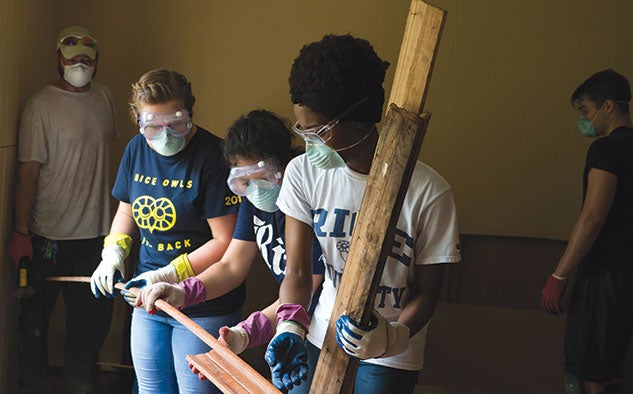On Disaster and Resilience

Fall 2017
By David Leebron
Each disaster has its own unique footprint. For a hurricane, it will depend on the exact path of the storm, its strength in terms of wind velocity, its speed as it moves across the land, the amount of precipitation and other factors. And it will depend on the landscape below, natural and built, and the capacity of the built environment to deal with each of these factors.
Beyond that, we must understand resilience — the ability of both human society and aspects of the environment to respond and recover following the disaster. That will depend not only on the extent of the damage, but also on the vulnerabilities and capacities of individuals and institutions. What is the quality of the governmental, nonprofit and volunteer response? Are individuals insured, and how rapidly are payments made? Do they have other resources that enable them to quickly recover and resume not only their basic lifestyle, but also employment, purchasing and other economic activity?
Hurricane Harvey was by any measure a disaster; its record rainfall across the coastal region, and particularly in the Houston area, produced flooding unlike any we had seen before. Harvey’s rainfall was roughly twice that of Tropical Storm Allison. The homes of more than 100,000 people suffered significant damage, and many of those became uninhabitable. Several dozen people lost their lives. A number of downtown cultural venues suffered significant damage and won’t be able to reopen for many months.
However, the infrastructure remained largely intact. Shelters were set up for those who became homeless, but quickly dissipated as people found new places to live or were accommodated by relatives and volunteers. Commercial flights resumed within four days or so. Even at the lowest point, about 95 percent of homes had electricity, and that number was promptly restored to nearly 100 percent.
At Rice, we recovered incredibly quickly. If not for the difficult situations faced by many of our employees, we could have reopened on the Tuesday after the storm. Because of investments and preparations — both long in advance and shortly before the storm — damage was relatively minor. Our amazing facilities personnel quickly identified and repaired much of the damage. When we reopened on Tuesday, Sept. 5, all but one class was staffed. We provided financial and volunteer assistance to employees who had suffered significant harm. Our students and staff reflected the true caring spirit of the Rice community.
That is the nature of disasters: Previously existing disparities are exacerbated. This results not merely from the greater vulnerability of their residences and the lack of resources to recover, but also from governmental decisions that neglect essential infrastructure or other investments that enhance disaster resiliency among the broader population.
In Houston, the immediate consequences of the storm spread across all socio-economic groups. Wealthy families with beautiful homes near bayous saw the destruction of years of investment in their residences; but for the most part, they were fully insured and had the capacity to find new residences. For the poor and lower-middle class, the consequences were devastating. Many had no flood insurance. Those in apartments that suffered significant damage were often evicted with no place to go. A recent report said that two-thirds of American families do not have enough savings to deal with a $500 emergency. That was certainly the situation for many of these families and, as the Houston Chronicle pointed out, many who had just achieved a middle-class lifestyle suddenly found themselves pushed back out of that status. Many who thought they had achieved stability for their families were abruptly among the ranks of the homeless.
That is the nature of disasters: Previously existing disparities are exacerbated. This results not merely from the greater vulnerability of their residences and the lack of resources to recover, but also from governmental decisions that neglect essential infrastructure or other investments that enhance disaster resiliency among the broader population.
Across our campus, we have faculty members who make the study of these kinds of disparities and inequities their primary scholarly endeavor. In what ways do segments of our population face more severe health challenges and consequences? Why do the educational opportunities of poorer children remain so deficient, and what can be done to change that? Why are so many people in our cities unable to participate fully in the economic success of those cities? These are problems always worthy of study, but for a city like Houston that possibly faces increasingly severe storms, we need to understand how those events affect the least well off among us.
Research universities like Rice have the capacity to contribute to every aspect of disaster prediction, preparation and recovery, and there are no other institutions in the U.S. that can play those roles with the needed expertise and neutrality. From understanding climate change and severe weather patterns to the investments to reduce flooding during and after a storm, much of the critical expertise rests in universities. The same is true for the human and social effects, and for the broad range of choices we make regarding buildings and infrastructure. Nearly every school at the university and a wide array of disciplines have a role to play. We are committed to, and well engaged in, that task.
